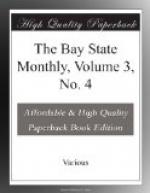In due season the governors of the Cotton States, by official orders to their extemporized militia companies, took forcible possession of all the property belonging to the Federal Government lying within the borders of these States. This proceeding was no other than levying actual war against the United States. There was as yet no bloodshed, however, and for this reason: the regular army of the United States amounted then to but little over seventeen thousand men, and, most of these being on the Western frontier, there was only a small garrison at each of the Southern forts; all that was necessary, therefore, was for a superior armed force—as a rule, State militia—to demand the surrender of these forts in the name of the State, and it would at once, though under protest, be complied with. There were three notable exceptions to this peaceable evacuation,—first, no attempt was made against Fort Taylor, at Key West; Fort Jefferson, on Tortugas Island; and Fort Pickens, at Pensacola, on account of the distance and danger; second, part of the troops in Texas were eventually refused the promised transit, and were captured; third, the forts in Charleston harbor underwent peculiar vicissitudes, which will be recounted later on.
The conspiracy which, for a while at least, seemed destined to overcome all obstacles, was not confined to South Carolina or the Cotton States. Unfortunately it had established itself in the highest official circles of the National Government. Three members of President Buchanan’s cabinet—Cobb, of Georgia, Secretary of the Treasury; Floyd, of Virginia, Secretary of War; and Thompson, of Mississippi, Secretary of the Interior—were rank and ardent disunionists. To the artful machinations of these three arch-traitors, who cared more for self than they did for the South, the success of the conspiracy was largely due. Grouped about them was a number of lesser functionaries, willing to lend their help. Even the President did not escape the suspicion of the taint of disloyal purpose.
The first and chief solicitude of the disunionists of South Carolina was to gain possession of the forts. A secret caucus was held. “We must have the forts,” was its watchword; and, ere long, from every street corner in Charleston came the impatient echo: “The forts must be ours.”
To revert to the beginning. On the 1st of October, 1860, the Chief of Ordnance wrote to Secretary Floyd, urging the importance of protecting the ordnance and ammunition stored in Fort Sumter, Charleston harbor, providing it met the approval of the commanding officer of Fort Moultrie. The Secretary had no objections; but the commanding officer of Fort Moultrie, while giving a very hesitating approval of the application, expressed “grave doubts of the loyalty and reliability of the workmen engaged on the fort,” and closed his letter (dated November 8th) by recommending that the garrison of Fort Moultrie should be reinforced,




